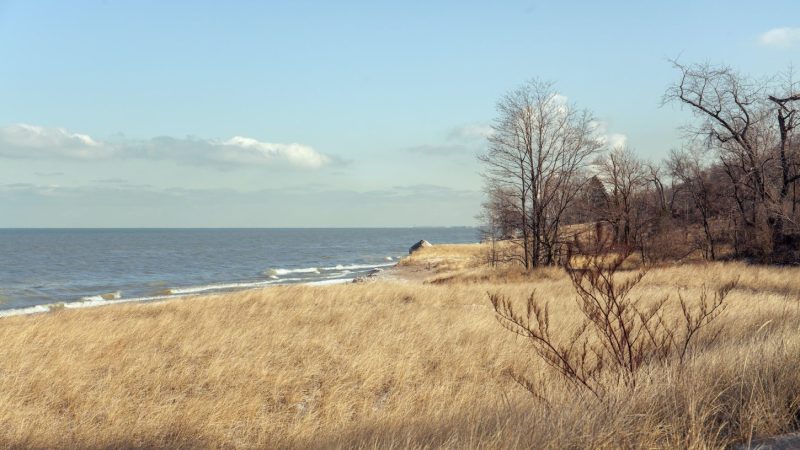
Overlooking the southern shores of Lake Michigan, the Indiana Dunes National Park has long captivated visitors. In fact, it was there in the late 19th century that Henry Cowles, a botanist from the University of Chicago, studied the intricate ecosystems along the lake. His groundbreaking work established Cowles as “the father of modern ecology” in the United States. A little bit of history for your next trivia night.
Most people come to climb to the top of 194-foot Mount Tom, one of several towering dunes lording over the lakeshore. The park is home to gorgeous beaches and the biological diversity that so astonished pioneering botanists like Cowles. Meandering rivers, oak savannas, windswept prairies, and verdant wetlands are all part of the serene backdrop of one of America’s newest national parks — becoming the country’s 61st in 2019. If you haven’t made a visit yet, we have the guide to get you there.
Related Guides
- Best National Parks to Visit in Spring and Summer
- Best Time to Visit National Parks
- Best National Parks for RV Camping
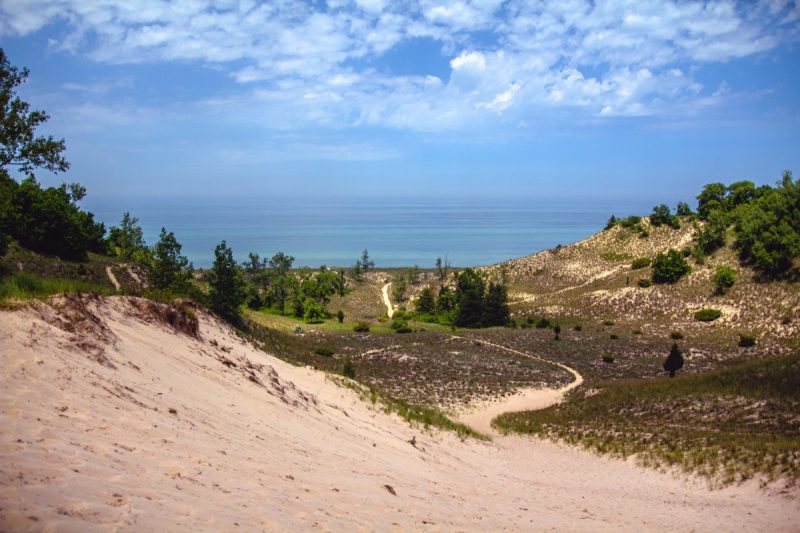
Exploring the lay of the land at Indiana Dunes National Park
- It’s a smaller national park
- Plenty of animals and plants to check out
- Shoreline for days
- Close to Chicago
At just under 24 square miles, the dune-filled reserve isn’t quite the smallest national park in the country (that honor goes to the 91-acre Gateway Arch National Park in St. Louis). Despite its tiny stature, the park is home to a wide variety of plant and animal life, including 46 species of mammals and 60 butterfly species, as well as carnivorous pitcher plants, rare orchids, and 1,000 other species of flora.
Migrating birds fill the skies in April and September, while even the sands harbor life, like the six-lined racerunners (a type of lizard) and a native species of prickly pear cacti.
The placement of this national park seems rather unpromising at first. Chicago lies 40 miles to the northwest, and the remnants of an industrial corridor fringe the park on either side (the Nipsco power plant only looks nuclear). Once you’ve made peace with the setting, you’ll appreciate this protected landmark for all its surprising allure.
Another important feature to note is the non-contiguous layout of the park. It follows the shoreline, with a few small interruptions as it swerves inland near Gary and at the Port of Indiana.
The park also surrounds the smaller Indiana Dunes State Park, which, unlike the national park, has a small entrance fee. It’s worth visiting both, as the state park is home to some of the highest dunes over the lake.

How to prepare for your trip to Indiana Dunes National Park
- Make it a day trip
- Add it on to a tour of Chicago
- Spend a weekend taking in all of the dunes
You could immerse yourself in all the Indiana Dunes has to offer over a three or four-day holiday, or make the national park one stop on a bigger excursion in the region. One appealing option is to spend a few days in Chicago before heading down to the dunes, then following the lakeshore east and north as it passes some gorgeous scenery in Michigan.
If you have time for a road trip, keep heading around the lake along Michigan’s western shore. Within an hour, you’ll reach the charming waterfront towns of Harbor Country, where you’ll find antique shops, galleries, fine beaches and some decent surfing.
Keep heading north for more bucolic charm, including Sleeping Bear Dunes and the Manitou Islands. If you don’t want to retrace your steps, keep going to Muskegon (a 2.5-hour drive north of the national park), and catch a ferry across the lake to Milwaukee, which is about 100 miles north of Chicago.
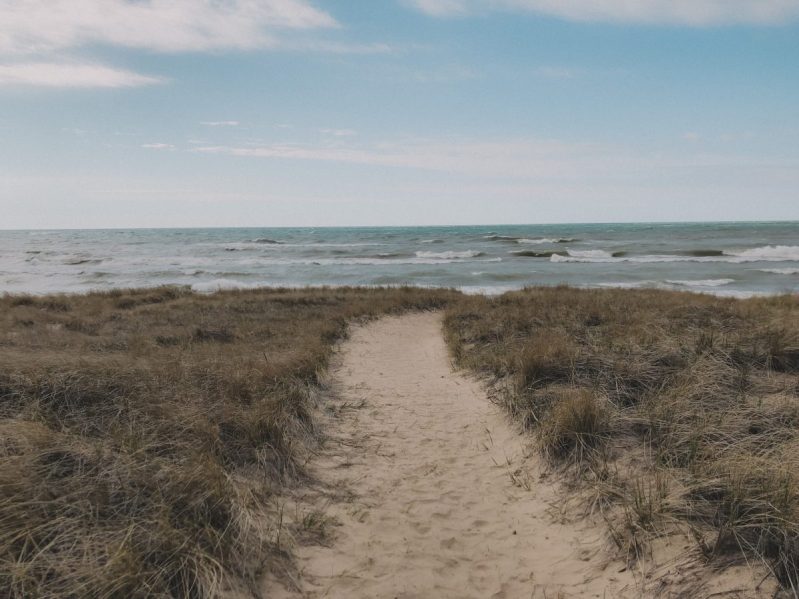
Where to stay near the Indiana Dunes National Park
Chicago makes a fine base for visiting the park as a day trip, but if you’re looking to reconnect with nature, you’re better off staying in the area.
There are several decent camping options there, including the Dunewood Campground, which has well-spaced forest-shaded spots. To be even closer to the lake, book a site in the Indiana Dunes State Park. This will give you prime dune access at sunrise and sunset, which are magical times to experience the shoreline.
The best non-camping option is the Duneswalk Inn, set in an 1881 three-story brick mansion. The family-run inn has attractive guest rooms with wood floors in a great location a few minutes’ drive to the lake. The best rooms have fireplaces and small kitchen units. Soundproof windows dampen the noise of US-20, which runs past the inn.
Four miles south of the lakefront, Riley Railhouse occupies a converted railroad freight station, and it’s a major draw for train lovers with its imaginatively furnished rooms and common areas full of vintage train memorabilia. The Upper Berth room has a small balcony overlooking the tracks where trains still trundle past.
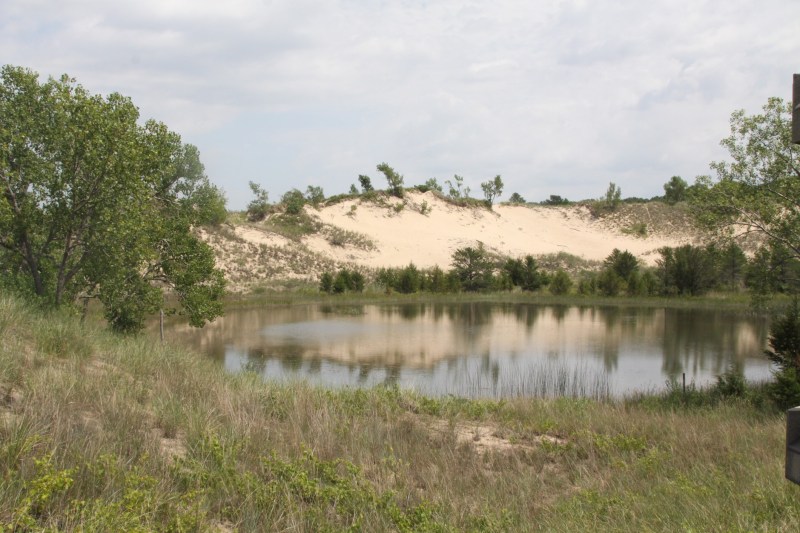
What to do during your stay
Basking on the beach is one of many ways to spend a sun-drenched afternoon at the Indiana Dunes. You’ll find serene nature walks amid the park’s diverse ecosystems, kayaking on forest-lined waterways, and biking the many trails in the region.
Walking Trails
The Dune Succession Trail takes you up some 270 steps to a lofty perch with sweeping views — all the way to Chicago on clear days. The mile-long walk illustrates various stages of dune development, from a bare beach to a forested section growing right out of the sands.
The 3.9-mile Little Calumet River Trail leads you out past the Mnoké prairie, through the forest, and over tiny bridges, with plenty of opportunities to spy birds and other wildlife along the way.
It’s worth paying a visit to the Indiana Dunes State Park for its three-dune challenge. You’ll climb a 1.5-mile trail that takes you up the three highest peaks on the shoreline for a cumulative total of 522 vertical feet (about 55 stories) over sand and along stairs in order to reach the panoramic views atop Mount Tom, Mount Holden, and Mount Jackson.
Don’t miss a visit to the Cowles Bog Trail, a 4.7-mile path that provides a fine overview of the wetlands’ biological diversity. You’ll pass ponds, marshes, and black-oak savannas. Before heading back, make the steep descent to the beach for a tranquil view over the lakeshore.
Biking
An interconnected trail system encompasses 37 miles (60km) across the national park and goes past shimmering dunes, wind-whipped prairie, and sun-dappled forests. Memorable jaunts include the 2.1-mile Marquette Trail and the 10.3-mile Prairie-Duneland Trail, both of which follows an abandoned rail line. Various outfitters rent bikes, including Pedal Power, handily located next to the Indiana Dunes Visitor Center.
Read more: Best Rails to Trails in America for Cycling
Historical sites
In 1822, Joseph Bailly established one of the first fur-trading posts in the area, and it served as a crossroads and meeting spot for Native Americans and Euro-American colonists. After checking out the rustic log and brick buildings of the Bailley Homestead, continue on the trail to the nearby Chellberg Farm to learn about a pioneering Swedish immigrant family that put down roots there in the 1880s. Out back, get your barnyard animal fix, with cows, chickens, pigs, and goats.
At Dunbar Beach, take an architectural stroll past the 1933 Century of Progress Homes. Originally exhibited for the 1933 World’s Fair in Chicago, these five homes were purchased by real estate developer Robert Bartlett and brought mostly by barge to their present location on the lakeshore. Bartlett envisioned a planned resort community, called Beverly Shores, complete with a hotel, golf course, and housing developments.
Today, the entire district is a historic landmark, where you’ll get a glimpse of the future through the lens of 1930s design by checking out the once-innovative constructions along Lake Front Drive. Most eye-catching is the Florida Tropical House, painted in flamingo pink, while the glass-walled House of Tomorrow was built to include its own airplane hangar.
Beach-going
You won’t lack appealing places to relax on the shoreline, with 15 miles of beachfront along Lake Michigan. Among the park’s different beaches, a perennial favorite is West Beach, which is great for swimming if you don’t mind the chilly waters. It has a lifeguard station in the summer and an enticing expanse of sand for beachcombing and relaxing by the water’s edge. It’s also the westernmost of the park’s nine beaches, and right at the base of the popular Dune Succession Trail, making it a great place to cool off after making the trip to the top.
You’ll find fewer crowds at Kemil Beach, and getting there takes you on one of the park’s most scenic drives, which follows a winding forest-lined road. After visiting the sandy shores, hike the short (0.7-mile) Dune Ridge Trail, a wooded dune that offers views over the wetlands and forests to the south.
Further east, Central Avenue Beach is another quiet spot to enjoy nature. Come early or late in the day to see waterfowl and shorebirds, as well as bank swallows that nest in the dunes during spring and early summer.
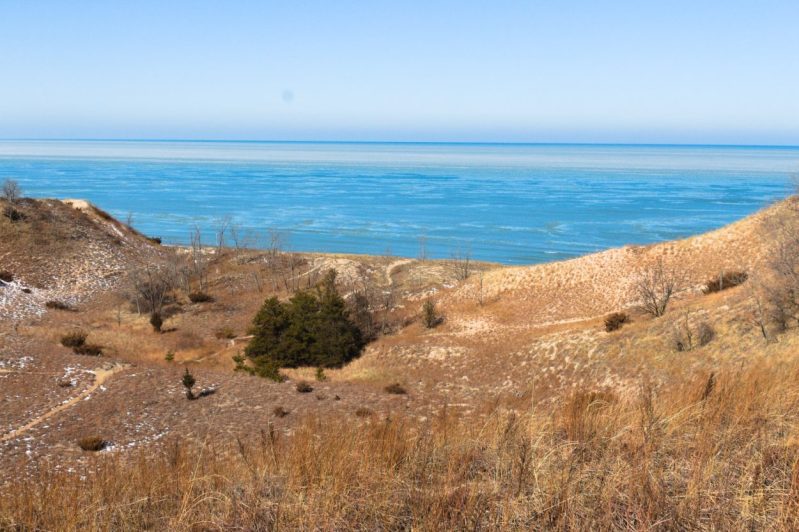
Important details to know when visiting the Indiana Dunes National Park
Best time to visit
- Fewer crowds in the spring and the fall
- Middle of the week is best
- Don’t skip the winter
- May is for bird watching
The park is open year-round, with camping available from April through October. The big crowds come from June through early September, though mid-week is much quieter. Swimming is always a chilly endeavor, though more bearable in July and August.
But don’t neglect the winter! It does get cold by the lake, but there is still so much to see and everything else to see and places to eat are open.
If you are into birds, then go in May. There’s a whole Indiana Dunes Birding Festival every May that you won’t want to miss.
Getting there
- Drive on in
- Fly as close as possible
- The train is the most fun
The national park is a short hop from Chicago (40 miles northwest) and lies between the towns of Gary and Michigan City. While most visitors come by car, it’s easy to reach the dunes by train. From Chicago, the South Shore Line has four stops in the park: Miller, Ogden Dunes, Dune Park, and Beverly Shores.
What to pack
- Sunscreen
- Sunglasses
- Layers
- Sneakers
You might think with all of that walking that you’ll need to bust out the hiking boots. Well, you might want to. But the majority of the trails will really only need your favorite pair of sneakers. The main thing is that the weather there never gets it together, so it’s best to wear a few layers just in case. You are by the water, after all.
The Midwest has its gems, and the Indiana Dunes National Park is definitely one of them. While suggesting a trip to The Region might make some people tilt their heads, once they’ve seen the beauty that the Dunes has to offer, they’ll understand.
Editors' Recommendations
- Visiting the Grand Canyon? Your complete guide for a Northern Arizona road trip
- Yellowstone National Park issues a new warning (and we can’t believe people need to be told this)
- There’s a new ranking of the 10 best national parks and some surprising faves aren’t on it
- The most and least visited National Parks: See popular sites (or avoid crowds)
- Take a break at one of these U.S. National Parks this winter




